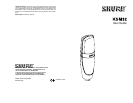
English – 3
OPERATION
Position the microphone so that the side marked “Shure”—the side opposite
the switches—faces the sound source.
Power
The KSM32 requires phantom power. Optimal performance will be achieved
when using a 48 Vdc supply (IEC-268-15/DIN 45 596). The microphone oper-
ates with supplies as low as 11 Vdc.
Mounting
The ShureLock swivel mount and elastic shock mount provide a secure
means of fastening the microphone to a floor or boom stand. When using the
swivel mount, the internal shock mount provides good isolation. For greater
reduction of noise from external vibrations, use the elastic shock mount.
It is important when mounting the microphone that the threaded, knurled
locking grip on the shock mount or swivel mount is screwed securely onto the
threads at the base of the microphone. Do not overtighten.
Integral Pop Filter
The KSM32 has an integral pop filter which provides excellent protection
against most wind and breath noise. An external pop protection screen may
be necessary when close-miking vocalists. The use of a low frequency cutoff
filter may also be effective.
Selecting Low-Frequency Response
A three-position switch on the back of the KSM32 allows you to adjust the
low-frequency response of the microphone. The low-frequency filter settings
can be used to compensate for wind noise, room noise or proximity effect.
Flat response. Use this setting for any application where you desire
the most natural reproduction of the source. The microphone will reproduce
ultra-low frequencies, and the ShureLock elastic-suspension shock mount
may be required to reduce mechanical vibrations transmitted through the mi-
crophone stand.
Low-frequency cutoff. Provides 18 dB-per-octave cutoff at 80 Hz.
Helps eliminate stage rumble or other low-frequency room noise such as that
coming from heating, ventilation, or cooling (HVAC) systems. It may also be
used to compensate for proximity effect or to reduce the low frequencies that
can make an instrument sound dull or “muddy.”
Low-frequency rolloff. Provides a 6dB-per-octave rolloff filter at
115Hz. Use this setting with vocals or instruments to compensate for proximity
effect or to reduce the low frequencies that can make an instrument sound dull
or muddy.










